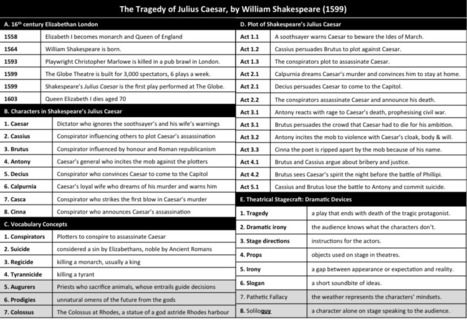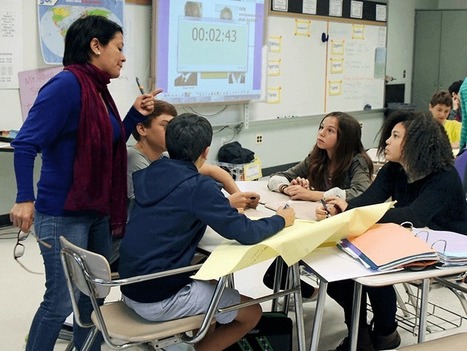 Your new post is loading...
 Your new post is loading...
Using Wikipedia in the classroom has been shunned traditionally by some teachers because it is written by volunteers on the internet. But it is precisely that crowdsourced nature that makes Wikipedia such a compelling tool in the classroom, says Nichole Saad, senior program manager for education at Wikimedia Foundation, the nonprofit that owns Wikipedia.
Via Elizabeth E Charles
A part-time professor is one of many at Point Park taking innovative approaches to boost student engagement during COVID-19.
Via EDTECH@UTRGV, Elizabeth E Charles
One of the perks of teaching online is that there are so many great tools that make facilitating an online course easier. For example, not having to manually grade and enter grades for online exams since most learning management systems can automatically evaluate student responses and submit scores to a gradebook without the instructor needing to do a thing.
With the ability to automate so much of an online course, along with the physical separation from your students, it can be challenging to find ways to let your personality, teaching style, and personal touches shine through in the online environment.
Here are three easy strategies that you can begin trying and implementing in your teaching today to bring a bit more of your personality to your online courses.
Via Elizabeth E Charles
It's easy to say that students lie to teachers all the time. Frankly, everyone, including teachers, has a lie in them, and these untruths keep the schooling process rolling along. When adults say, for instance, that they develop rules with the students, chances are that students often develop rules that teachers already thought of anyway. Or, when adults say that a student can't use the restroom during certain parts of the day "Just because," rather than "Because the hallways is crowded, and I don't want you distracted from the lesson in the classroom,” that's just one more micro-fib in a collage of fibs that we tell children.
Via Elizabeth E Charles
Whether you're brand-new to block scheduling or you've been doing it for years, these strategies will have you handling those 90 minutes like a boss.
Via Miloš Bajčetić
For us at Michaela, knowledge is powerful: it empowers our pupils to achieve in their academic subjects, to understand the world and to live fulfilling lives. It is one of our highest priorities in our teaching at Michaela.
There are some who take umbrage with the implication that they don’t teach knowledge. ‘We already do all that,’ is the response I’ve heard from many teachers. Equally, some are under the impression that teaching knowledge is equivalent to exam drilling. This is a complete misconception. Teaching knowledge is absolutely not narrow teaching to an exam specification at all, but instead, teaching broad, deep subject expertise.
Via Elizabeth E Charles
Caring in education. In this article Nel Noddings explores the nature of caring relations and encounters in education and some of the difficulties educators have with them. She also looks at caring...
Via Elizabeth E Charles
History teacher Bill Tolley offers tips on adapting to learning environments that combine face-to-face instruction with self-directed online experiences.
Via Elizabeth E Charles
This is number 8 in my series on learning theories. My intention is to work through the alphabet of psychologists and provide a brief overview of each theory, and how it can be applied in education. In the last post we examined the various educational theories of John Dewey including experiential learning. In this post, we explore the work of Yrjö Engeström on Activity Theory.
Via Elizabeth E Charles
This is number 26 in my series on learning theories. I'm working through the alphabet of psychologists and theorists, providing a brief overview of each theory, and how it can be applied in education. Previous posts in this series are all linked below. The previous post highlighted issues around the theory of Communities of Practice, from the work of Jean Lave and Etienne Wenger. In this post, I'm revisiting a well known and heavily used motivational theory - Maslow's Hierarchy of Human Needs.
Via Elizabeth E Charles
|
Even when we teach with consistent, planned strategies, every student experiences instruction in a different way. When we embrace that diversity of experience among our students and recognize that what works for some may not work for others, doors open: We can plan multiple routes for engagement, representation, and expression, which enables more students to succeed. Universal Design for Learning (UDL) is an education framework that helps teachers support students across that span of the student experience. I
Via Elizabeth E Charles
Individuals vary in their views of what students should be taught. How should teachers discuss the misdeeds of a nation’s founders? What is the minimum accomplishment expected of each student in mathematics? But there is no disagreement on the importance of critical thinking skills. In free societies, the ability to think critically is viewed as a cornerstone of individual civic engagement and economic success.
But is there evidence that explicitly teaching critical thinking brings any benefit? There is, and such evidence is available for different subject matters. For example, in one experiment researchers taught college students principles for evaluating evidence in psychology studies – principles like the difference between correlational research and true experiments (Bensley and Spero, 2014). These principles were incorporated into regular instruction in a psychology class, and their application was practised in that context. Compared to a control group that learned principles of memory, students who learned the critical thinking principles performed better on a test that required evaluation of psychology evidence.
Via Elizabeth E Charles
15 Reflection Strategies To Help Students Retain What You Just Taught Them by Terry Heick Reflection is a natural part of learning. We all think about new experiences–the camping on the car ride home, the mistakes made in a game, or the emotions felt while finishing a long-term project that’s taken months to complete. Below …
Via Ana Cristina Pratas, Elizabeth E Charles
When other teachers, even other ESL teachers, hear I'm teaching an ESL conversation class, they often say i
Via Juergen Wagner
As teachers, we are always looking for fresh teaching strategies that allow our students to retain and process the information that we teach them. Sometimes we tell our students to reread something in hopes that it will help them remember it better. Other times we encourage them to practice, practice, practice because we have all heard the saying “Practice makes perfect.” But we all know that in reality, some things just go in one ear and out the other. In fact, research has shown that if we don’t do anything with the new information that we learn within one hour of learning it, we will have forgotten about 50 percent of it.
Via Elizabeth E Charles
"Many years later, as he faced the firing squad, Colonel Aureliano Buendía was to remember that distant afternoon when his father took him to discover ice."
In a conversation I had with Ken Bain, my longtime mentor and favorite education writer, he cited that quote — the first sentence of Gabriel García Márquez’s novel One Hundred Years of Solitude — as one of the great openings in literary history. It’s hard to disagree: The sentence plunges us immediately into a drama, acquaints us with a character on the brink of death, and yet intrigues us with the reference to his long-forgotten (and curiosity-inducing) memory. That sentence makes us want to keep reading.
Via Elizabeth E Charles
Sometimes even well-planned lessons fail. This list of sponge activities will help you cope with the unexpected and re-engage your students. Learn more about how to put rough days in perspective and recalibrate in the associated post: "Academic Sponge Activities."
Via Elizabeth E Charles
Whether you use musical instruments, game pieces, call-and-response, or electronic devices, there are many successful ways of getting students to focus front and stop talking.
Via Beth Dichter
"Which teaching strategy works best?" This is a question that many educators ask my colleagues at McREL. It's an earnest question, but it's a bit like walking into a gym full of workout equipment and asking a trainer, "So which exercise is best?" The answer, of course, depends on where you are in your fitness regime and what you're trying to accomplish."
Via Beth Dichter
This is number 26 in my series on learning theories. I'm working through the alphabet of psychologists and theorists, providing a brief overview of each theory, and how it can be applied in education. Previous posts in this series are all linked below. The previous post highlighted issues around the theory of Communities of Practice, from the work of Jean Lave and Etienne Wenger. In this post, I'm revisiting a well known and heavily used motivational theory - Maslow's Hierarchy of Human Needs.
Via Elizabeth E Charles
|



 Your new post is loading...
Your new post is loading...




























